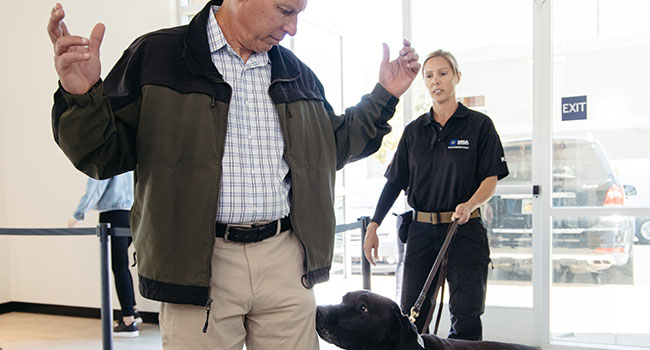
Not Your Typical Dog Next Door
Canines, the new normal at many retail centers
- By Glen Kucera
- Jul 27, 2023
According to the National Retail Federation, nearly 60% of retail security executives report concerns with the rise in mass violence and active assailants over the last five years. This growing threat presents a risk that endangers consumers, staff and brands. To address these potential threats, retail management are increasingly deploying canine security teams trained to detect firearms.
As highly trafficked, accessible sites, retail centers are particularly vulnerable since they are open to the public sometimes 15 hours a day with no requirements for security sign-ins “at the door.” The deployment of firearm detection canine teams serves as a visible deterrent to prevent and reduce crime at retail sites. These highly trained teams of handlers and dogs are responsible for helping to keep thousands of shoppers, employees and vendors safe by effectively detecting various materials unique to firearms such as ammunition, cleaning solvents, oils, holster materials and other related odors.
For these canines, imprinting begins early to identify scents specific to firearms. A professionally trained firearm detection dog will successfully sniff out separate odors and passively “sit” alerting the security handler of a threat, even if the gun has never been loaded or previously fired in the last six months. Firearm detection canines are also trained in odor tracking so they can identify a firearm on a moving person and follow the scent to the source, even in crowded venues.
A typical day for a firearm detection canine team is busy and active. They patrol a mall or shopping center against the flow of patron traffic, and as shoppers pass, the canine turns its head into the trail of the odor. If an odor unique to firearms is detected, the canine will turn and follow them.
In addition, canines can perform accurately without close contact, intrusive or invasive searches of individuals and are trained to operate in accordance with their handler’s direction.
For indoor settings, canines can effectively screen persons who are up to six to 10 feet away. In outdoor settings, canines will not alert on an odor unless they are actively searching, as directed by the handler. They also are trained to ignore the persistent scent associated with their handler’s firearm and are only rewarded when alerting to a weapon on another person, while actively searching.
Once a canine alerts on someone carrying a firearm, it is instructed to observe, or take an overwatch position, while that person is interviewed by the client.
Canines are acclimated to various weather types and are trained to effectively detect odors in a wide range of inclement weather conditions, such as rain, snow and excessive wind. They are highly-motivated to work and remain undeterred by adverse environments that might otherwise limit technology security solutions. In extreme conditions, handlers closely monitor their canine’s behavior, adjusting the pace of work to provide adequate rest in climate-controlled environments.
As the security and threat landscape evolves, it is important for businesses to continually review and evaluate their security plans and procedures to keep pace with their specific security needs. Adding firearm detection canine teams to an existing security strategy is an effective method to deter criminals and to detect the presence of harmful threats at retail sites.
Firearm detection canines, combined with security professionals, smart cameras and other security technology provide a comprehensive approach to the evolving risks and threats faced by retail centers each day.
About the Author
Glen Kucera is the president of MSA Security, an Allied Universal company.